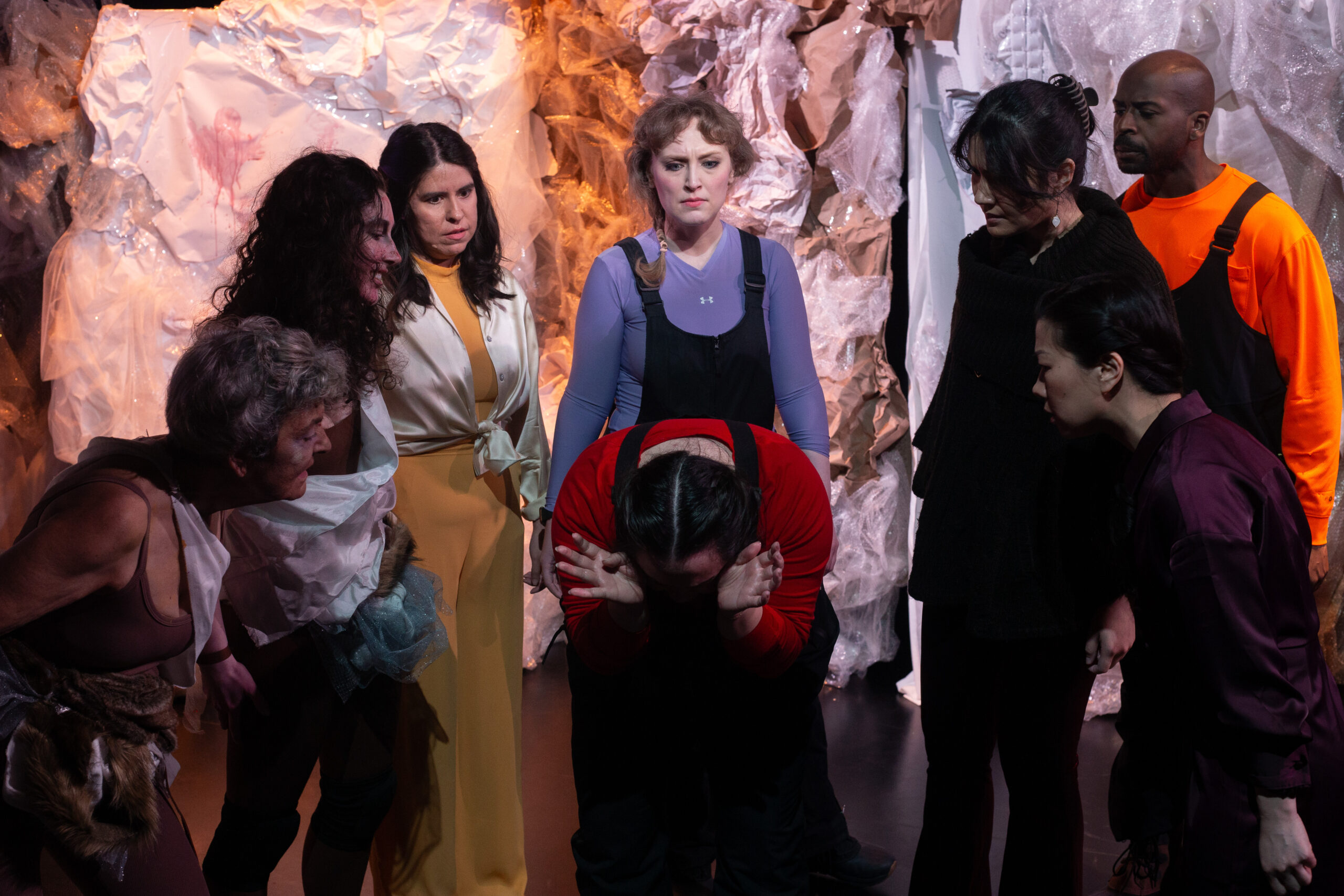
This Avalanche Theatre world premiere, at the Bramble Arts Loft, might win the Adam Kaz Critic Award for Year’s Coolest Title. Time Is a Color and the Color Is Blue by Melanie Coffey follows glaciologist Whittaker (Alice Wu) into an Arctic cave where, after observing the first known cave painting, she becomes trapped with little oxygen. The production suffers from a weak set design and script issues, but the performances and family drama carry the piece.
I can’t say I’m thrilled by the set. In a small black box we face a wall of mushy, mishappen white stalagmites and rocks. This is our Arctic cave. A closer inspection crystallizes the situation. That this ice wall is made from bubble wrap, paper bags, bedsheets, and othe r motley white materials.
No doubt scenic designers Micaela McCabe and Ab Rieve want to fulfill the production note, “This work must be produced in as sustainable and environmentally friendly manner as possible.” In my eyes, though, it looks uneven and cheap. The white shines a little better during the more dramatically lit scenes, courtesy of lighting designer Nathan Keiller, but not that much better, and I fear the set design is an unnatural disaster, the wrong side of DIY.

The production builds an effective atmosphere in other ways. Composer Eva Mattioli provides a nice Social Network-esque piano chord progression that at different times punctuates our main character’s elation and fear. And of course Alice Wu as Whittaker, who is onstage practically the entire show, does an admirable job pummeling through the heady and weighty content of this unique production.
Whittaker’s excitement and awe observing the first known cave painting splinters when she realizes she’s trapped in a cave with no air pockets. A seasoned glaciologist, Whittaker understands the danger. A storm rages outside, no one from base can save her. Spiraling through guilt and fear, the audience enters Whittaker’s psyche as she interacts with hallucinated people from her past and present.
Some of the play’s strongest moments occur between Whittaker and her hallucinated sister, played by Stephanie Fongheiser. Describing her oppressive guilt, Whittaker tells her sister, “And sometimes I tread water. But other times I let the water take me. And for those moments, under water—my guilt water—breathing it in, I’m not so tired any more.”
That’s a cool metaphor, one of the strongest moments in the script. I saw some audience members tear up watching Whittaker navigate conversations with these apparitions. Cleverly on Melanie Coffey’s part, Whittaker’s projections are a combination of fact and fiction, hopes and false memories. Coffey takes this concept to interesting places; sometimes Whittaker tells her hallucinations they’re acting incorrectly, sometimes she experiences memories she knows are inaccurate.

The family and relationship explorations are all worthwhile, though the show falters with its other major theme: cosmic insignificance. Whittaker spends a good deal of time considering her importance related to the cave painting and the ancient Earth time it represents.
I groan at lines like, “But you hold a sample in gloved hands and you’re holding compressed snow that fell before homo sapiens even existed,” and “Earth time is so difficult to comprehend that people just don’t. It’s too big.”
Space is large and time is long. And by comparison people’s lives are very small and short. We get it. This is tired ground; audiences are reminded of this constantly in film and television. If our small size was ever a controversial concept, it certainly isn’t now. In fact, if a show were to argue we were important in the grand scheme of things, that would be surprising.
There are other, more functional issues with the play as well. In a B plot Whittaker’s team leader and lover Bridget, played by Martina Logan, frantically communicates over walkie-talkie with fellow scientist Jackson, played by Bryan Nicholas Carter, about their teammate lost in a cave. We know Bridget is at the base, and we know Jackson is in the lab, and we know Whittaker is trapped in a cave, but how far these locations are from each other isn’t entirely clear. And so conversations about whether they can find Whittaker feel incomplete.
I also took issue with the portrayal of cave people. In an unexpected twist, the cave painting’s originators enter Whittaker’s imagination. Harper McCoy plays Tilda and Mary Mikva is Milly, two vaguely defined early humans. The issue is the actors aren’t quite on the same page. McCoy’s Tilda is more serpentine, she slinks around and accentuates snakyness. Whereas Mikva’s Milly speaks and acts more humanlike. Neither performance is better than the other, but the show as a whole would benefit if they made a decision on how to perform these humanoids. As it stands, they act like different species.
Ultimately, this show delivers in a lot of ways. There are far worse ways to spend your time. Wu keeps our attention with her powerful performance, the ruminations on family and guilt are strong, and maybe some of the weaker portions—the design, the cosmic talk—won’t bother other theatergoers so much.
Time Is a Color and the Color Is Blue by Avalanche Theatre continues at the Bramble Arts Loft, 5545 N Clark St, thru May 24. Running time is 75 minutes with no intermission. Ticket prices start at $15.
For more information on this and other productions, see theatreinchicago.com.
Support arts and culture journalism today. This work doesn't happen without your support. Contribute today and ensure we can continue to share the latest reviews, essays, and previews of the most anticipated arts and culture events across the city.
